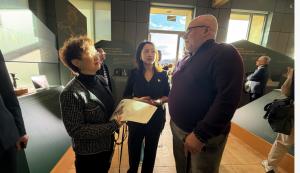'Behind Masks: Discovering Sanxingdui and Jinsha' Exhibition and Academic Symposium in Oxford, UK
The “Behind the Masks: Discovering Sanxingdui and Jinsha” exhibition and an academic symposium was held at St Anne’s College, University of Oxford.
OXFORD, UNITED KINGDOM, November 10, 2025 /EINPresswire.com/ -- From November 8 to 12, the “Behind the Masks: Discovering Sanxingdui and Jinsha” exhibition and an academic symposium was held at St Anne’s College, University of Oxford. The event was jointly sponsored by the Sichuan Provincial Cultural Heritage Exchange and Information Center, the Sanxingdui Museum, and the Jinsha Site Museum, and cohosted by Foreign Language Teaching and Research Press (UK) and Southwest Jiaotong University.The exhibition showcased the archaeological findings from the Sanxingdui site in Guanghan and the Jinsha site in Chengdu, Sichuan province, through multimedia forms such as graphics, images, and videos, introducing the unique artistic accomplishments and spirit realm of the ancient Shu civilization. The opening ceremony on November 8 presented 14 replicas of important cultural relics such as bronzes and gold artifacts, including the “Bronze Sacred Tree”, the tallest known bronze artifact from the Shang and Zhou periods, the most intact “Bronze Standing Figure”, and the “Bronze Altar”, a representative ritual relic of the ancient Shu civilization, along with the exquisitely crafted “Sun and Immortal Bird” gold ornament and gold masks. Augmented Reality (AR) technology was also used to reconstruct the archaeological excavation and the landscapes of the sites, providing visitors with an immersive cultural experience.
The opening ceremony was attended by Chinese representatives including Pu Xin, Deputy Director of the Sichuan Provincial Cultural Heritage Administration, Wang Fang, Deputy Director of the Jinsha Site Museum, Feng Shiwei, Deputy Director of the Sanxingdui Museum Management Committee, and Xie Zhenbin, Vice President of the Sichuan Museum. The British representatives included experts and scholars from the University of Oxford, Foreign Language Teaching and Research Press (UK), the Oxford International Centre for Publishing, and other UK universities. Pu Xin, and James Hutchings, representative of the British host organization, both highlighted the success of the exhibition and the continued cooperation between China and the UK in cultural heritage in their speeches.
The Sanxingdui site, discovered in Guanghan, Sichuan in 1927, is hailed as “one of the most significant archaeological discoveries of the 20th century in China”, unveiling a previously unknown chapter of the ancient Shu civilization. The Jinsha site, unearthed in Chengdu in 2001, and the Sanxingdui site sharing the same origin, collectively contribute to shaping the panorama of the ancient Shu civilization. Dame Jessica Rawson, renowned British art historian, archaeologist, sinologist, and Professor of the University of Oxford has described Sanxingdui as “extraordinary, stunning, and unique”, suggesting that its artifacts “reflect not real life, but the thought and imaginary world of the ancient Shu people”.
On the afternoon of November 8, the academic symposium on Sanxingdui and Jinsha was held in the lecture hall of St Anne’s College. Focusing on “Understanding China through Archaeology: History, Culture, and Art”, the symposium brought together many experts and scholars from the fields of archaeology and museology in both China and the UK.
Ms. Wang Fang, Deputy Director and Researcher of the Jinsha Site Museum, delivered the opening address. Dr. Anke Hein, Associate Professor of Archaeology at the University of Oxford, focusing on “Interaction between Mountain Civilizations in Western Sichuan and the Ancient Shu Culture”, explored the cultural ties between the ancient Shu civilization and the eastern rim of the Tibetan Plateau. Professor Li Haichao from the School of Archaeology and Museology, Sichuan University, elaborated on “Resources and Rituals: The Rise and Fall of Ancient Shu and its Resource Interaction Network”, and analyzed the role of resource use and religious rituals in the development of civilization. Dr. Wang Shengyu, Associate Researcher of the Hong Kong Palace Museum, focusing on “Gold Artifacts from Sanxingdui and Jinsha: Light, Space, and a System of Decoration”, explained the symbolic significance of gold artifacts within the aesthetic and religious systems of ancient Shu society. Professor Dame Jessica Rawson delivered concluding remarks for the symposium.
This event stands as a testament to the steadily enhanced cultural exchanges between China and the UK. Foreign Language Teaching and Research Press (UK), Southwest Jiaotong University, and the Sanxingdui Museum have collaborated on multiple events since 2022, including the “Discovering Sanxingdui” dialogue between Chinese and international archaeologists and the “Wonderful Journey of Sanxingdui” interactive program for youth. These activities have drawn broad engagement from UK university and school students, faculty, and the public, and laid a solid foundation for the promotion of the ancient Shu civilization in Britain.
The “Behind the Masks: Discovering Sanxingdui and Jinsha” exhibition and symposium brought together and demonstrated a spectrum of archaeological achievements from Southwest China in the UK. This event stands as another significant accomplishment in Chinese-British collaboration in cultural heritage preservation, academic research, and mutual learning of civilization, further fostering understanding and cultivating appreciation of ancient Chinese civilization and art among overseas audiences.
CRIonline
CRIonline
email us here
Legal Disclaimer:
EIN Presswire provides this news content "as is" without warranty of any kind. We do not accept any responsibility or liability for the accuracy, content, images, videos, licenses, completeness, legality, or reliability of the information contained in this article. If you have any complaints or copyright issues related to this article, kindly contact the author above.



